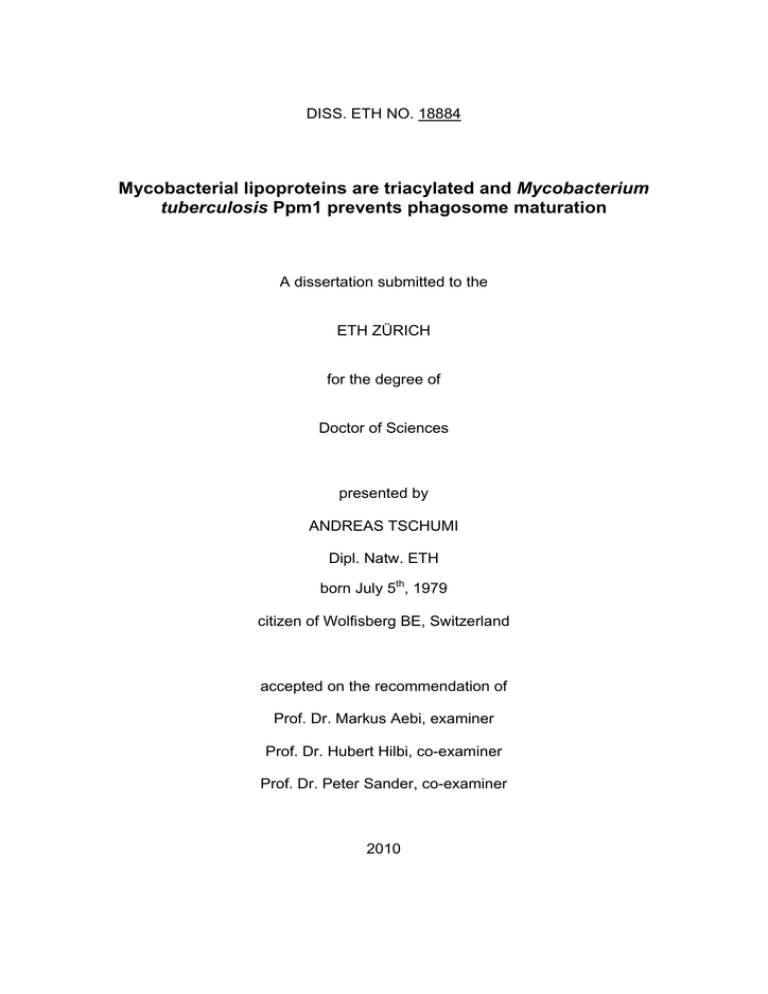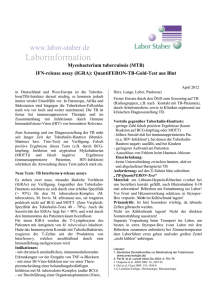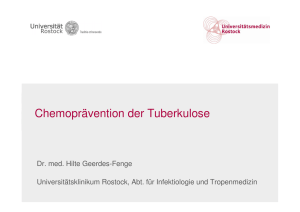Mycobacterial lipoproteins are triacylated and - ETH E
Werbung

DISS. ETH NO. 18884 Mycobacterial lipoproteins are triacylated and Mycobacterium tuberculosis Ppm1 prevents phagosome maturation A dissertation submitted to the ETH ZÜRICH for the degree of Doctor of Sciences presented by ANDREAS TSCHUMI Dipl. Natw. ETH born July 5th, 1979 citizen of Wolfisberg BE, Switzerland accepted on the recommendation of Prof. Dr. Markus Aebi, examiner Prof. Dr. Hubert Hilbi, co-examiner Prof. Dr. Peter Sander, co-examiner 2010 Summary Tuberculosis is an infectious disease caused by the bacterium Mycobacterium tuberculosis that claims about 1.8 million lives annually, and one third of the world’s population is infected with this bacterium. Therefore, tuberculosis is the second most frequent cause of death related to infectious diseases. Due to the slow growth of M. tuberculosis the therapy lasts at least six month but also the growing amount of antibiotic resistant bacteria and bacteria resistant to almost every available drug pose severe problems. Thus, not only new anti-tuberculosis drugs but also new potential drug targets need to be identified. Possible candidates are the M. tuberculosis lipoproteins. Mycobacterial lipoproteins are secreted and immunmodulatory proteins. They are posttranslationally modified at the +1 cysteine of a consensus sequence termed lipobox motif. The modifications are consecutively mediated by three enzymes: 1) formation of a thioether linkage between the conserved cysteine residue and a diacylglycerol catalyzed by phosphatidylglycerol:pre-prolipoprotein diacylglycerol transferase (Lgt), 2) cleavage of the N-terminal signal peptide by the prolipoprotein signal peptidase/signal peptidase II (LspA), and 3) in the case of Gram-negative bacteria, aminoacylation of the N-terminal cysteine residue by phospholipid:apolipoprotein N-acyltransferase (Lnt). It has been shown that the mycobacterial cell envelope resembles that of Gram-negative bacteria although mycobacteria belong to the group of Gram-positive bacteria. Therefore, it is hypothesized that mycobacterial lipoproteins may be N-acylated but so far, this has not been proven. Aim of this study is to characterize the modifications of mycobacterial lipoproteins with the focus of potential N-acylation and its role in the virulence of M. tuberculosis. Isogenic knock-out mutants in the genes homologous to Escherichia coli Lnt have been generated in M. tuberculosis and in the non-pathogenic M. smegmatis strain. Using M. tuberculosis lipoprotein LppX, heterologously expressed in M. smegmatis, we showed that mycobacterial lipoproteins are N-acylated besides being modified by Lgt and LspA. We identified lnt ORF’s responsible for the aminoacylation of LppX. In M. tuberculosis the lnt gene is fused to the ppm1 gene and builds a two domain protein. Ppm1 is known to be involved in the synthesis of substrates used for the biosynthesis of the cell wall glycoprotein lipoarabinomannan. In mice infection experiments, only an M. tuberculosis Δppm1 mutant showed reduced CFU levels after 3 weeks post infection, whereas the M. tuberculosis Δlnt mutant showed no significant difference to mice infected with the wildtype strain. Applying subcellular fractionation techniques on M. smegmatis strains expressing the M. tuberculosis -9- lipoprotein Mpt83 we investigated the impact of the N-acylation on transport of lipoproteins. In the wildytpe strain we localized Mpt83 in the cell wall, whereas in the M. smegmatis lnt::aph mutant, Mpt83 was found to be localised in the cytoplasmic membrane. This indicates that N-acylation is a prerequisite for lipoprotein transport to the cell wall in mycobacteria. - 10 - Zusammenfassung Tuberkulose ist eine bakterielle Infektionskrankheit, die durch das Bakterium Mycobacterium tuberculosis verursacht wird. Sie fordert jährlich ungefähr 1.8 Millionen Todesfälle. Ein Drittel der Weltbevölkerung ist infiziert mit dem Tuberkulose-Erreger. Damit ist die Tuberkulose die 2. häufigste Todesursache unter den Infektionskrankheiten. Ein grosses Problem der Tuberkulose-Therapie bereitet das langsame Wachstum des Bakteriums, durch das eine Therapiedauer von sechs Monaten unabdingbar wird, und die immer grösser werdende Zahl von Bakterien, die nicht nur resistent gegen die herkömmlichen Medikamente sind sondern zusätzlich gegenüber fast allen vorhandenen Antibiotika. Deshalb ist es eminent wichtig nicht nur neue Medikamente sondern auch neue Angriffsziele für neue Medikamente zu finden. Einen potentiellen Pool an Angriffszielen bilden die Lipoproteine von M. tuberculosis. Mykobakterielle Lipoproteine sind post-translational modifizierte, sekretierte und immunomodulierende Proteine. Eine Gemeinsamkeit der Lipoproteine ist das Vorhandensein einer Konsensus-Sequenz, die Lipobox, welche aus vier Aminosäuren besteht. An der posttranslationalen Modifikation sind Pre-prolipoprotein Diacylglyceryltransferase (Lgt) und die Lipoprotein Signal Peptidase (LspA) beteiligt. In Gram-negativen aber nicht in Grampositiven Bakterien folgt noch eine dritte Modifikation, katalysiert durch die Apolipoprotein N-Acyltransferase (Lnt). Lgt überträgt ein Diacylglycerol an das universell konservierte +1 Cystein, LspA schneidet das Signalpeptid ab und Lnt überträgt eine Fettsäure an die freie Aminogruppe des Cysteins. Da die mykobakterielle Zellwand funktionell einer Gramnegativen Zellwand ähnelt, obwohl Mykobakterien zu den Gram-positiven Bakterien gezählt werden, vermuteten wir, dass mykobakterielle Lipoproteine ähnlich wie in Gram-negativen Bakterien prozessiert werden. Dies konnte aber bislang nie gezeigt werden. Ziel dieser Arbeit ist die Untersuchung und Charakterisierung des Lipoproteinstoffwechsels in Mykobakterien und die Untersuchung ihres Einflusses auf die Virulenz, wobei der Schwerpunkt auf das lnt Gen gesetzt wurde. Das Gen mit der höchsten Homologie zum lnt von Escherichia coli wurde in M. smegmatis und M. tuberculosis durch gezielten Genaustausch deletiert. Untersuchungen mit dem M. tuberculosis Lipoprotein LppX, heterolog exprimiert in dem apathogenen Modell-Organismus M. smegmatis zeigte, dass Lipoproteine in Mykobakterien dreifach acyliert sind. Das als lnt identifizierte Gen codiert für ein Enzym, welches eine Fettsäure auf die primäre Aminogruppe des universell konservierten Cysteins überträgt. In M. tuberculosis ist das lnt Gen mit dem - 11 - ppm1 Gen fusioniert, ein Gen verantwortlich für die Generierung des Zellwand Glykolipids Lipoarabinomannan. Eine M. tuberculosis Δlnt Mutante zeigte keine Virulenzattenuation in aerogen infizierten Mäusen. Dies zeigt, dass Lnt in M. tuberculosis keinen Einfluss auf die Virulenz des Bakteriums hat. Die Deletion beider Domänen des Proteins, sprich Lnt und Ppm1, aber bewirkte eine Verminderung der Koloniebildenden Einheiten in diesem Virulenzmodell. Mittels subzellulärer Fraktionierung eines weiteren heterolog exprimierten M. tuberculosis Lipoproteins, Mpt83, wurde der Einfluss der N-Acylierung auf den Transport von Lipoproteinen untersucht. Im M. smegmatis Wildtyp Stamm wurde Mpt83 in der Zellwand lokalisiert, wohingegen in der Lnt Mutante das Mpt83 in der Zytoplasmatischen Membran gefunden wurde. Dies zeigt, dass die Lnt Modifikation eine Voraussetzung für den Transport von Lipoproteinen in die Zellwand des Bakteriums ist. - 12 -

